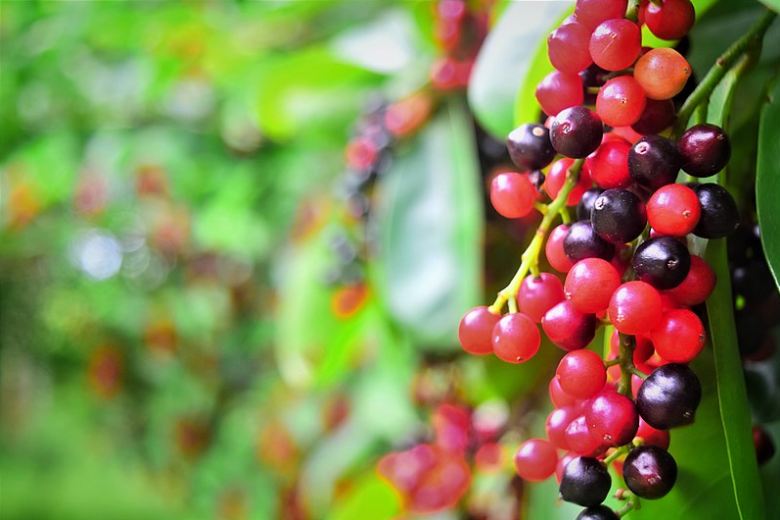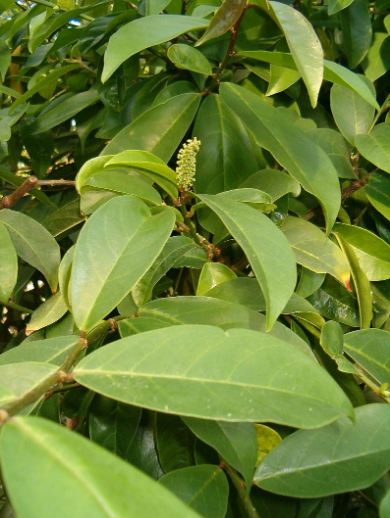Antidesma Bunius or Bignay/Bignai is a small bushy tree found in tropical regions. It is also named currant tree, Chinese laurel, and buni. This 3-6m tall plant is dioecious, and its height can even reach 15-30 meters. This plant can grow in both semi-shade and no shade (dark) areas. This evergreen plant can grow in three kinds of moist soil:
- Light sandy soil
- Medium loamy soil
- Heavy clay soil
What Does Antidesma Bunius Look Like?
This small tree is usually 3-10 meters tall, its trunk is straight, and the branches are usually present close to its base. The leaves of Antidesma are dark green, have a shiny look, and are long and narrow in structure with very short petioles. The male and female flowers grow on separate trees; these flowers have no odor and are reddish. The flowers of Bignay are pollinated by insects, and it is not a self-fertile plant.
The fruit of Antidesma is round and oval, and it grows in clusters just like grapes. The fruit of Bignay is edible and is usually eaten raw, but it can also be cooked and used in jams and jellies. The young leaves of Bignay are also edible. These edible young leaves are usually used in salads and steamed as a side dish. The bark/trunk of this plant contains a toxic alkaloid that is injurious in many ways. This tree s also considered an ornamental plant.
Origin
The Antidesma is commonly found in the lower Himalayas in India, Southeast Asia, and Ceylon. In the Philippines, Antidesma Bunius is an abundantly found plant. In Malaysia, this plant is cultivated occasionally, while in Indonesia, it is commonly grown in almost every village from where the fruit of this plant is marketed in clusters.
In South Florida, only a few Antidesma Bunius trees were planted in the past. The fruit from the plants was primarily used for juices and jellies, but today the fruit of Antidesma is rarely used in Florida.
The tree of Antidesma Bunius is also found in the following countries:
Asia, Australia, Bhutan, Brazil, Burma, Cambodia, China, Himalayas, India, Indochina, Indonesia, Laos, Malaysia, Myanmar, Nepal, Northeastern India, Pacific, Papua New Guinea, Philippines, PNG, SE Asia, Singapore, Solomon Islands, South America, Sri Lanka, Thailand, USA, Vietnam.
Suitable Climate
The Antidesma tree is not strictly tropical; it thrives in Java. It grows very well and blooms flowers in Israel but doesn’t set fruit there.
Propagation
New Antidesma Bunius plants can be raised from seeds, but there are other ways of propagating this plant. Usually, the propagation of Antidesma is done by grafting, cuttings, and air layering. It is recommended by Ochse that grafting of this tree should be done in the wet season as in the dry season, the scions remain dormant. The slow germination of the vegetative seedling propagation is often used, helping grow the seedlings faster and the tree to start flowering and producing fruit sooner than normal.
Season of Growth
The flowers of Antidesma Bunius bloom in the spring season. These trees bloom in the Indonesian region in September and October while the fruits ripe in February and March. In North Vietnam, the fruiting season starts in July and ends in September.
Uses of Antidesma Bunius
In Southeast Asia, Antidesma Bunius, along with its other uses, also has edible and medicinal uses. In Florida, the leaves of Antidesma can be heavily attacked by sooty mold, scale insects, or mealybugs. The foliage can also be subjected to algal leaf spots and green scurf, which is caused by Cephaleuros virescens.
Edible Uses
Two parts of Antidesma are edible, which are the young leaves and the fruit. The fruit of Antidesma can be eaten raw, cooked, or in jam and jellies. The fruit’s skin becomes stiff when it is fully ripped, and it is slightly sweet and juicy. Mainly this fruit is eaten by kids as a snack. The round fruit of Antidesma is about 8mm in diameter, while the seed is relatively large.
To make jam or jellies of Bignay, some extra pectin is needed to create the jelly-like property. The fruit grows in a cluster and is tasted by the tasters who identify the bitter ones among these fruits. If you place the extracted Bignay juice in the refrigerator for a day or more, you will notice a settling of astringent sediment. This settling can be removed, and the flavor can be improved like this.
On the other hand, the young leaves are eaten raw in salads and can also be steamed as a side dish. When cooked, these leaves turn brown, and their texture is retained. They can also be cooked with other foods to impart their sour flavor to other foods.
Medicinal Uses
The leaves of Antidesma are sudorific, and in Asia, they are used for treating snakebites. The leaves and the roots of this plant are used for the treatment of traumatic injuries. The leaves of Antidesma Bunius are also used for the treatment of cough, syphilis, gonorrhea, and ingestion.
Other Uses
Other than medicinal and edible uses, the following are some other uses of Antidesma Bunius:
- The bark/trunk of Antidesma is used for yielding strong fiber for cordages and ropes.
- The timber of Antidesma is used for making cardboard after being pulped.
- Antidesma is occasionally employed in reforestation projects.
- It is cultivated for its shapely form to use as an ornamental plant.
- The low branching structure of this plant is also suitable for planting as a privacy screen, shade, or a windbreak.
- The leaves are used as a culinary herb for adding flavor to the food, specifically in rice.
Cultivation Details
Antidesma grows best and thrives in hot and humid tropical lowlands. These plants can tolerate light frosts occasionally. The best circumstances for better growth of this plant include a sunny or light shade position and fertile and moisture-retentive soil. The preferred pH range for this plant is 6-7, but it can tolerate a pH level of about 5.5-8. It is desirable to have wind protection when the trees are still young.
The trees start producing fruit in about 5 to 6 years from seed. In grafted plants, the fruit can be produced in 2 to 3 years. To some people, the heavy fragrance of the male flowers is very obnoxious. These trees are dioecious, which means there are separate male and female trees, but the female tree can freely form fruit even in the absence of a male tree. One male tree is required for every 10 or 12 female Antidesma trees in order to provide cross-pollination.
Problematic Features
Following are some features of this tree that are regarded as problematic:
- The birds eat the fruit and disperse the seeds.
- In many publications, it is listed as a weed.
- In French Polynesia, the plant is recorded as an invasive species.
- The juice of its fruit is so intensely colored that it leaves stains on fingers, garments, and mouth.
Conclusion
Antidesma Bunius is a small bushy tree found in tropical regions of the lower Himalayas in India, Southeast Asia, and Ceylon. It can be raised from seeds, but there are more methods of propagating it too. Not just it can is edible but also used for its medicinal properties. Once propagated, the trees start producing fruit 5 to 6 years.



